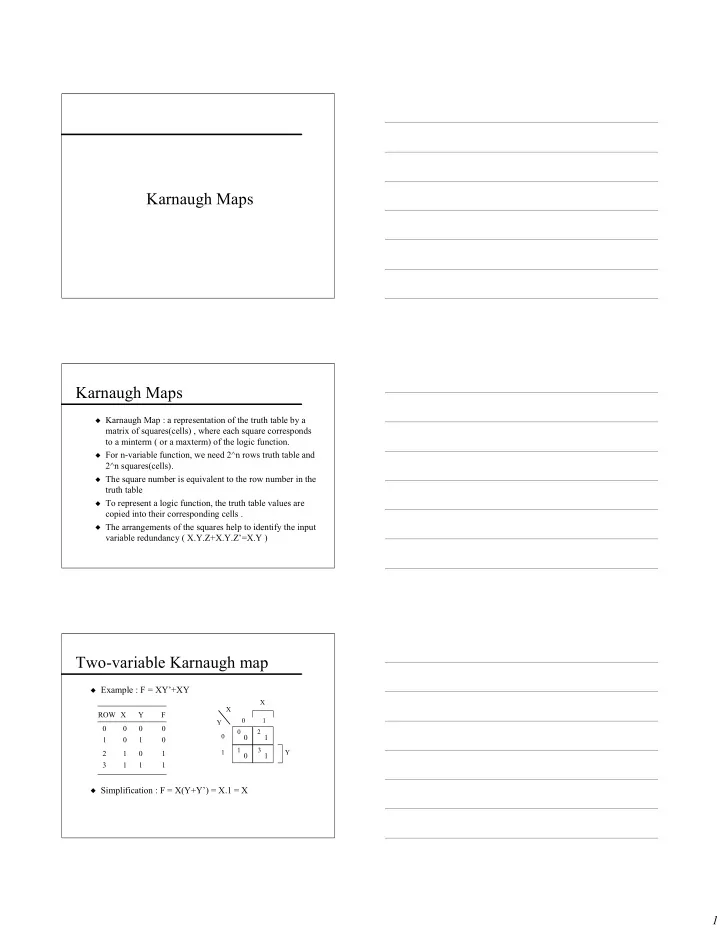

Karnaugh Maps Karnaugh Maps ◆ Karnaugh Map : a representation of the truth table by a matrix of squares(cells) , where each square corresponds to a minterm ( or a maxterm) of the logic function. ◆ For n-variable function, we need 2^n rows truth table and 2^n squares(cells). ◆ The square number is equivalent to the row number in the truth table ◆ To represent a logic function, the truth table values are copied into their corresponding cells . ◆ The arrangements of the squares help to identify the input variable redundancy ( X.Y.Z+X.Y.Z’=X.Y ) Two-variable Karnaugh map ◆ Example : F = XY’+XY X X ROW X Y F 0 1 Y 0 0 0 0 0 2 0 0 1 1 0 1 0 1 3 2 1 0 1 1 Y 0 1 3 1 1 1 ◆ Simplification : F = X(Y+Y’) = X.1 = X 1
Three-variable Karnaugh map ◆ Example : F=X’.Y’.Z’+X’.Y’.Z+X.Y’.Z’+X.Y’.Z Row X Y Z F 0 0 0 0 1 X XY 1 0 0 1 1 2 0 1 0 0 00 01 11 10 Z 3 0 1 1 0 0 2 6 0 4 1 0 1 0 4 1 0 0 1 1 3 7 5 1 Z 5 1 0 1 1 1 0 0 1 6 1 1 0 0 7 1 1 1 0 Y ◆ F = X’.Y’.(Z’+Z)+X.Y’.(Z’+Z)=X’.Y’+X.Y’=(X’+X).Y’ = Y’ Four-variable Karnaugh map Row W X Y Z F ◆ W 0 0 0 0 0 1 WX 1 0 0 0 1 0 00 01 11 10 2 0 0 1 0 1 YZ 3 0 0 1 1 0 0 4 12 0 8 1 4 0 1 0 0 0 00 1 0 5 0 1 0 1 1 1 5 13 9 6 0 1 1 0 0 01 0 1 1 0 7 0 1 1 1 1 Z 8 1 0 0 0 1 3 7 15 1 11 0 9 1 0 0 1 0 11 0 1 10 1 0 1 0 1 Y 2 6 14 10 11 1 0 1 1 0 10 1 0 0 1 12 1 1 0 0 0 13 1 1 0 1 1 14 1 1 1 0 0 X 15 1 1 1 1 1 F= W’X’Y’Z’+W’X’YZ’+WX’YZ’+W’XYZ+WX’Y’Z’+WX’YZ’+WXY’Z+WXYZ ◆ Five-variable Karnaugh map ◆ Five variable K-map is formed using two connected four-variable maps: V VWX W W 000 001 011 010 100 101 111 110 YZ 0 4 12 8 16 20 28 24 00 1 5 13 9 17 21 29 25 01 Z 3 7 15 11 19 23 31 27 11 Y 2 6 14 10 18 22 30 26 10 X X 2
Dont Care Conditions : ◆ In some applications, the Boolean function for certain combinations of the input variables is not specified. The corresponding minterms (maxterms) are called “dont care minterms(maxterms)”. ◆ In K-map , the “dont care minterms/maxterms” are represented by “d”. ◆ Since the output function for those minterms(maxterms) is not specified, those minterms(maxterms) could be combined with the adjacent 1 cells(0-cells) to get a more simplified sum-of-products (product-of-sums) expression. Example ◆ Build a logic circuit that determines if a decimal digit is >= 5 ◆ Solution: ◆ - The decimal digits(0,1,2,...,9) are represented by 4 bit BCD code. ◆ - The logic circuit should have 4 input variables and one output. ◆ - There are 16 different input combinations but only 10 of them are used. ◆ - The logic function should produce 0 if the number is <5 , and 1 if it is >= 5 Example - The Truth table ◆ The Truth table for the function is specified as follows: Row W X Y Z F 0 0 0 0 0 0 1 0 0 0 1 0 2 0 0 1 0 0 3 0 0 1 1 0 4 0 1 0 0 0 5 0 1 0 1 1 6 0 1 1 0 1 7 0 1 1 1 1 8 1 0 0 0 1 9 1 0 0 1 1 10 1 0 1 0 d 11 1 0 1 1 d 12 1 1 0 0 d 13 1 1 0 1 d 14 1 1 1 0 d 15 1 1 1 1 d 3
Timing Hazards ◆ The Truth Table determines the Steady State behavior of a Combinational Logic Circuit ◆ Transient behavior : - Output could produce glitches when input variables change. - Glitches occur when the paths between inputs and output have different delays. - Timing Hazards refer to the possibility of having glitches during input transitions. ◆ Hazards : - Definitions. - Finding hazards. - Eliminating hazards. Example ◆ F= YZ+XZ’ ◆ Delay in each gate is T . ◆ Input changes from XYZ=111 to 110 X Y Y F Z Z Z’ X YZ XZ’ F glitch T 4
Recommend
More recommend